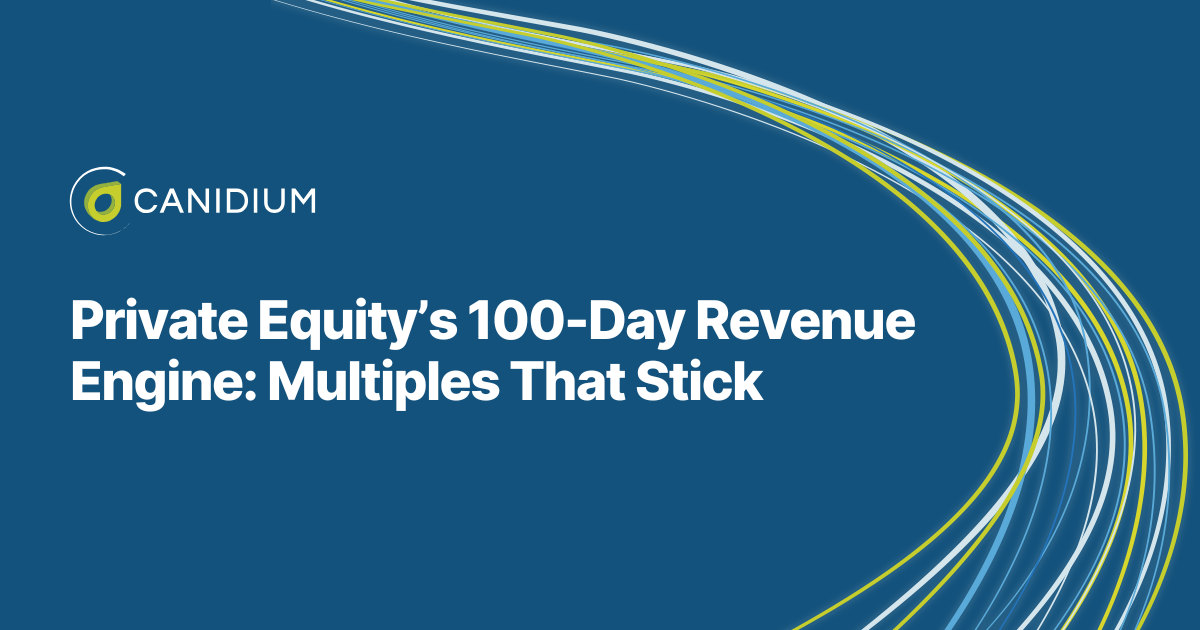Knowing when and when not to invest is vital for business leaders, but it is also difficult. There are many factors that play into a software investment, some of which are likely unique to your company’s business goals. However, there are guidelines you can use to determine if implementing an incentive compensation solution is right for your organization.
Our incentive compensation implementation team at Canidium helps clients determine whether or not they need new solutions, as well as which type of software aligns with their organizational goals.
To help you decide if incentive compensation software is right for you, this article covers the following topics:
- Why Companies Invest in Incentive Compensation Software
- 3 Reasons Not to Invest in Incentive Compensation Software
- The Top 2 Challenges of Timing Your Incentive Compensation Software Investment
Why Companies Invest in Incentive Compensation Software
Companies invest in incentive compensation software because it directly impacts their ability to retain top talent, motivate sales teams, and streamline complex compensation processes, leading to higher profitability and reduced operational costs.
The motivation and subsequent output of your sales reps directly reflect the quality of your comp plan strategy. In fact, compensation model revisions can have a 50% greater impact on sales than advertising investments.
Sales performance is improved by effectively leveraging incentive plans, and best-in-class incentive compensation software options such as Xactly or SAP SuccessFactors Incentive Management (SFIM) facilitate automated management of the complex compensation calculations required to initiate such plans. Plus, beyond managing the technical aspects of compensation plans, incentive comp software confers the following benefits:

Retention of Revenue Generators
The cost of losing skilled sales reps can be substantial, so to avoid high operating costs, you need to hold on to your sales team. There are many potential ways to increase your retention rates, but the most overlooked factor that impacts sales representatives is the visibility of their sales commissions.
When sales reps clearly see how their performance translates into earnings and can even forecast their potential pay based on pipeline activities, they are more motivated to stay and achieve targets. This directly reduces turnover, recruitment costs, and the time lost in onboarding new team members.
Enhanced Motivation and Performance
Put simply, when sales reps have real-time visibility into how their pipeline activities impact their compensation, they are more likely to proactively close deals, boosting company revenue.
Incentive compensation software gamifies sales performance, allowing reps to see how they rank against their peers and providing clear visibility into their earnings potential. This drives healthy competition, spurs motivation, and improves overall sales performance.
Reduction in Disputes and Administrative Time
Let’s face it, human error can significantly increase administrative operating costs. Manual incentive management processes often lead to inaccuracies and disputes over commission calculations, which can erode trust and morale.
Automating the process reduces disputes by ensuring transparency and accuracy in commission payouts. Moreover, this automation frees up substantial administrative time. For example, if a company spent 150 hours a month calculating commissions before an incentive compensation software implementation, it can now redirect that time toward more strategic tasks, such as refining compensation plans or developing new incentive strategies.
Scalability and Future-Proofing
As organizations grow, managing complex compensation plans becomes increasingly challenging. Spreadsheets may have sufficed at one point in your company’s development, but they are not viable for mid-sized or enterprise organizations.
Investing in scalable incentive compensation software ensures that compensation management processes are future-proofed and can grow with the organization. This reduces the need for future system overhauls and supports long-term business strategy alignment.
Heightened ROI
Incentive compensation software comes with a significant ROI. Companies can expect to see increased motivation among their sales team, resulting in better win rates. The software can also decrease administrative operational costs with automation, improve employee retention rates with better compensation processes, and increase incentive visibility.
Moreover, the software provides advanced reporting and analytics capabilities that deliver actionable insights into compensation effectiveness and sales performance trends. These insights allow companies to make data-driven decisions, refine compensation plans, and respond quickly to market changes, which helps keep sales teams aligned with business goals.
3 Reasons Not to Invest in Incentive Compensation Software
With all of the above benefits in mind, you might already be sold on the idea of incentive compensation software. However, as with any novel digital solution, there are a few reasons you may not need incentive compensation software, including the following.
- You don’t want to increase sales: It sounds like a joke, right? Well, surprising as it may sound to many sales managers who are trying to drive up numbers, there are several reasons why a company may not want to boost its sales. For example, if a company’s production or service capacity is limited, pursuing additional sales may lead to overcommitment and a decline in service quality. In these instances, you may want to focus on increasing sales margins with pricing software instead of incentive compensation solutions. Alternatively, if there are issues such as supplier shortages, shipping delays, or production bottlenecks, the company may not want to increase sales until these problems are resolved.
- You prefer performing manual processes: While some organizations have established methods of managing administrative tasks, the potential benefits of automation make this reason for avoiding incentive compensation software practically defunct. Change Resistance is a common problem for companies navigating digital transformation, but that does not mean it is a good reason to avoid software upgrades.
- You are okay with sales reps not understanding their potential commissions: Most sales leaders would likely object to this statement, but in actuality, the majority of reps don’t have easy visibility into their compensation structure. In fact, research indicates that only 24% of sellers can easily calculate their total variable compensation. This means that current compensation management processes are not effectively providing sales reps with the insights they need into their own commissions, which is a key driving force behind incentive compensation software investments.
The Top 2 Challenges of Timing Your Incentive Compensation Software Investment
Incentive compensation management software is a solid investment for most sales-based companies. However, for many in leadership, the question is not whether or not they should invest in compensation software but when they should.
Timing your incentive compensation software investment is a top concern for many sales managers. Typically, companies fall into one of the following two categories when timing their incentive compensation software investment:
.png?width=1920&height=1080&name=Why%20Companies%20Invest%20in%20Incentive%20Compensation%20Software%20(1).png)
Balancing Your Budget With Incentive Compensation Software Costs
If you are faced with budget constraints, hesitating to invest in incentive compensation software makes sense. The licensing and implementation costs of incentive management solutions require a significant investment.
This concern is common when companies are under budget reviews and must decide how to allocate limited resources. However, despite the initial expense, the long-term ROI of an incentive compensation solution can significantly outweigh the costs, making it a strategic decision that can unlock additional revenue potential and operational efficiencies.
One of the strongest arguments for investing in incentive compensation software sooner rather than later is the impact it has on reducing costly turnover. When sales representatives feel that their compensation is accurately calculated and transparent, they are more likely to remain with the company. This reduces attrition and eliminates the need for constant recruitment and onboarding of new talent—a process that is both time-consuming and expensive. In addition, companies with low turnover maintain stronger customer relationships and a more experienced sales team, which directly translates to better sales performance and higher revenues.
Furthermore, automated compensation systems drive improved sales performance by providing sales teams with real-time visibility into their earnings potential. When sales reps can see in real-time how their efforts impact their commissions, they are more motivated to focus on the deals that yield the highest return. This transparency not only motivates them to achieve and exceed their targets but also provides them with a clearer understanding of how to optimize their sales activities, leading to higher revenue generation. The enhanced motivation and productivity of the sales team alone can cover the initial cost of the software and generate additional profits for the company.
Operational efficiency is another compelling reason to invest in an incentive compensation solution. Many companies still rely on manual processes for calculating commissions, which are not only error-prone but also incredibly time-intensive. By automating these processes, organizations can eliminate calculation errors, reduce disputes, and significantly cut down on the administrative hours required to manage compensation. For instance, if a company’s finance or HR team spends 150 hours each month calculating commissions, automating this task could save nearly 1,800 hours annually. This freed-up time can then be redirected toward more strategic activities, such as developing innovative compensation plans, analyzing performance data, or focusing on employee engagement initiatives.
Prioritizing Your Different Software Implementation Projects
Even when companies have already allocated their budgets, they often face the challenge of deciding how to prioritize investments among multiple high-impact projects. There are always competing initiatives, such as implementing new CRM systems, upgrading payroll platforms, or rolling out other operational improvements that promise efficiency gains. However, when evaluating these options, investing in incentive compensation management should take precedence because it directly impacts the performance of the sales team—the very group responsible for driving revenue and, ultimately, funding these other initiatives.
The reason incentive compensation management should be prioritized above other projects is that it delivers immediate and measurable benefits by enhancing sales performance and optimizing compensation processes. While a CRM system might improve customer management, and an upgraded payroll platform might streamline payroll processing, neither of these investments directly influences the revenue-generating potential of your business in the same way a robust incentive management solution can. Salespeople are the front line of the company, and when they are highly motivated, understand their earning potential, and trust that their compensation is handled accurately, they become more productive and engaged. This means more closed deals, higher revenues, and a quicker return on investment—benefits that directly support the company’s bottom line and fund future initiatives.
Moreover, automating commission and compensation processes removes a significant administrative burden from the organization. Manually calculating commissions can be time-consuming and prone to errors, leading to frequent disputes and diminished trust in the compensation process. When sales teams have to worry about whether their commissions are calculated correctly, it distracts them from their primary goal of selling. In contrast, with an automated solution in place, not only are disputes minimized, but sales reps can see in real time how their performance impacts their earnings. This kind of visibility fosters a strong connection between effort and reward, driving more focused and effective sales behavior. By implementing an incentive compensation system, companies ensure that the people responsible for generating income are fully aligned with the company’s strategic objectives and motivated to contribute at the highest level.
Additionally, prioritizing an incentive management solution helps businesses quickly adapt to changing market conditions. In an environment where agility is key, having a flexible and scalable system for managing compensation allows organizations to implement new commission structures or incentives in response to market changes without the need for lengthy reconfigurations. This adaptability is crucial for staying competitive, as it allows the sales team to be responsive and aligned with new strategies almost immediately. Other projects, such as CRM implementations or payroll upgrades, do not provide this level of direct impact on revenue generation and workforce alignment.
Should You Invest in Incentive Compensation Software Now?
While it’s understandable that companies want to tackle multiple projects simultaneously or avoid investment costs, prioritizing incentive compensation management sets the stage for long-term success. It ensures that the salesforce—the engine of revenue generation—is fully optimized, engaged, and aligned with the company’s goals.
Ultimately, making incentive compensation management the top priority empowers organizations to maximize their resources, support future investments, and create a ripple effect of success throughout the business.
If you want to learn more about incentive compensation management, start by learning more about effective plan characteristics here.








